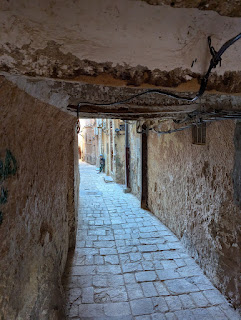Day 2 of Ghardaïa Algeria to see the oldest small town in the area and a have some tea in the Saharan desert dunes while watching a wonderful sunset. This was a great little weekend trip.
traffic circle decoration
El Atteuf
El Atteuf is the oldest town in the area of UNESCO World Heritage sites. We had an interesting guide take us around the town and to the Mausoleum of Cheikh Sidi Ami Brahim.
Algeria.com: The area was first settled by the Mozabites a branch of a large Berber tribe, the Iznaten, who lived in middle southern Algeria. The Mozabites became Muslims of the Mu’tazili school after the Islamic conquest. However, following the fall of the Rostemid state, some of the Rostemid royal family along with a number of loyal citizens settled in the M’Zab Valley, where they proceeded to convert the Mozabites from Mu’tazili to Ibadi – a form of Islam separate from both the Shi’a and Sunni denominations. France annexed the valley in 1882 and upon Algerian independence in 1962, the M’Zab Valley was incorporated into Algeria.
The architecture of El-Atteuf was greatly influenced by the Ibadi principles of functional purism, which calls for strict organization of land and space. Referred to as a qsur (ksar), meaning a “walled village”, El-Atteuf’s central feature is a mosque, with the minaret serving as a watchtower. Houses are situated in concentric circles around the mosque. The entire layout of the settlement promotes communal living and equality of the residents, while still respecting family privacy. Ibadi continues to be the predominant religion in El Atteuf and the other cities of the M’Zab Pentapolis, with a federal council, known as Majlis Ammi Said, uniting the settlements with regard to religious, social and cultural matters. The local language is Tumzabt, being a branch of the Zenati group of Berber languages.
The M’Zab Valley, including El-Atteuf, Ghardaia, Bounoura, Melika and Beni Isguen, was declared a UNESCO World Heritage Site in 1982 for it immense value as an intact example of traditional human habitat being perfectly adapted to the environment.
Cemetery
Mausoleum of Cheikh Sidi Ami Brahim
transportation options in the small streets
typical toilet
traffic circle decoration
Heading to the Dunes
is that a hole?
a truck
tourists posing for pictures
another pic of the hole that we didn't go check out
footprints in the sand because barefoot was easier
tea in the Sahara with you at sunset
flying back across some of the Saharan desert to our home on the coast in Algiers
The Police - Tea in the Sahara
My sisters and I
Have one wish before we die
And it may sound strange
As if our minds are deranged
Please don't ask us why
Beneath the sheltering sky
We have this strange obsession
You have the means in your possession
Tea in the Sahara with you
Tea in the Sahara with you
The young man agreed
He would satisfy their need
So they danced for his pleasure
With a joy you could not measure
They would wait for him here
The same place every year
Beneath the sheltering sky
Across the desert he would fly
Tea in the Sahara with you
Tea in the Sahara with you
Tea in the Sahara with you
Tea in the Sahara with you
The sky turned to black
Would he ever come back?
They would climb a high dune
They would pray to the moon
But he'd never return
So the sisters would burn
As their eyes searched the land
With their cups full of sand
Tea in the Sahara with you
Tea in the Sahara with you
Tea in the Sahara with you
Tea in the Sahara with you

















































































































No comments:
Post a Comment